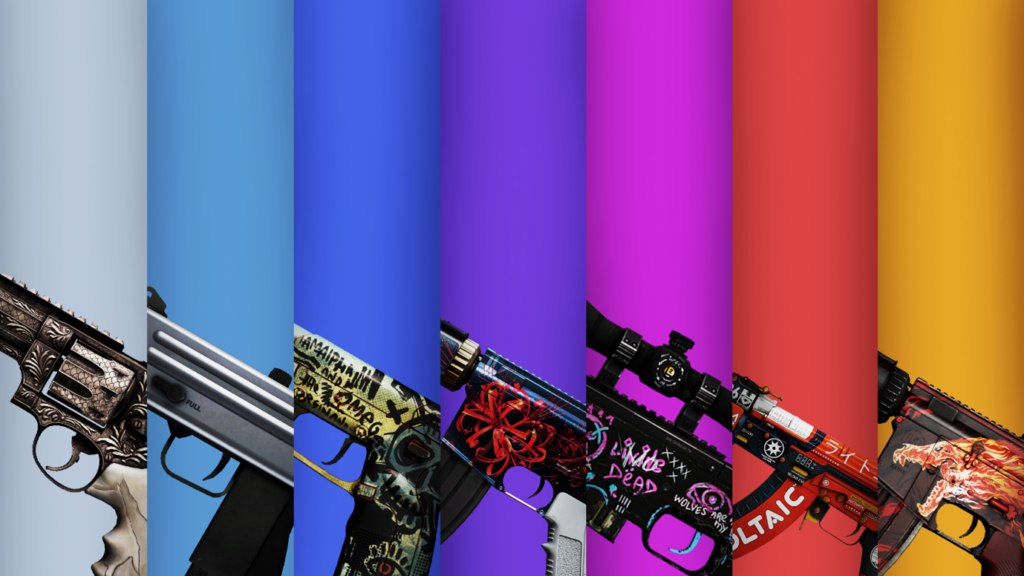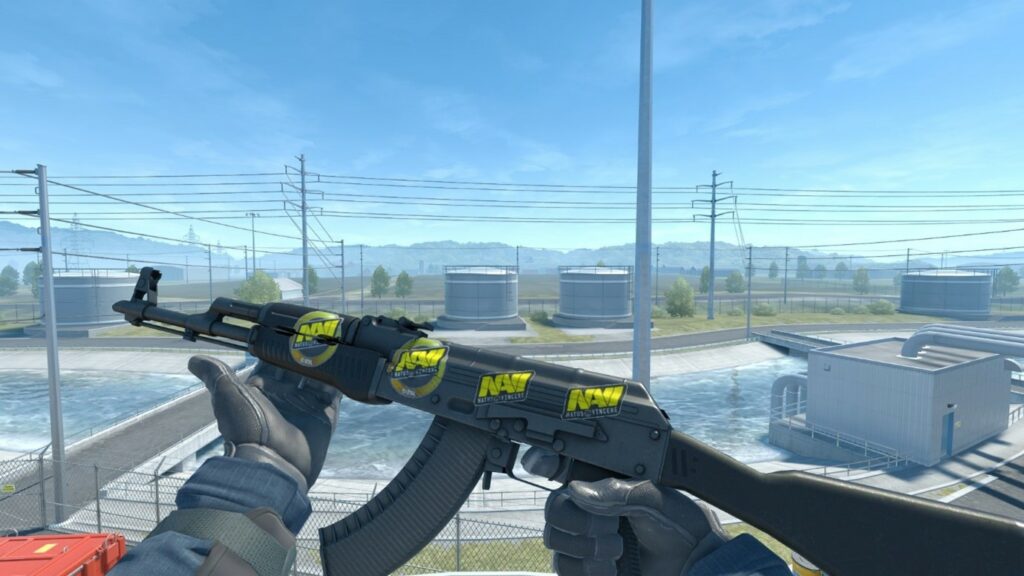
In the latter part of August 2013, CS2 underwent a significant change with the introduction of the Arms Deal Update by Valve, which introduced skins to the game. This update completely transformed the landscape of Counter-Strike 2, offering players the potential to profit from their in-game items.
Each CS2 item was assigned a specific monetary value based on factors such as skin rarity, float, and availability. The Steam marketplace emerged as a key platform for purchasing and trading skins, among other avenues. For newcomers, navigating the intricacies of CS2 trading can be challenging.
We are pleased to present a comprehensive guide on skin trading in CS2 for 2024. It’s crucial to understand the market dynamics before making significant investments.
Before, we get started, make sure to check out wiki.cs.trade for new weapon skins.
Understanding Skin Trading in CS2

Skin trading in CS2 involves exchanging in-game cosmetic items, known as skins, with other players. These trades typically occur within the Steam platform, although third-party platforms may also facilitate transactions.
Getting Started: Requirements
- Steam Account Creation
Begin by creating a Steam account, which serves as the primary platform for CS2 skin trading.
- Two-Factor Authentication
Enable two-factor authentication to enhance the security of your account.
- Profile Completion
Fill out your Steam profile with accurate information.
- Purchase History
Make a few purchases on Steam to ensure that your account has no restrictions.
Obtaining Skins
- Acquiring Skins
Before engaging in trades, you must acquire skins to offer for trade. This can be done through various methods, such as purchasing them from the Steam Market or opening cases.
- Research and Preparation
Take the time to familiarize yourself with the CS2 skin market and its nuances. Understand the factors influencing skin values, including rarity and demand.
- Beware of Scams
Educate yourself on common scams in skin trading to avoid falling victim to fraudulent schemes. Exercise caution when interacting with unfamiliar traders or third-party platforms.
Exploring the Skin Market
The CS2 skin market operates on principles of supply and demand, with prices fluctuating based on factors such as skin rarity, condition, and popularity among players. Understanding these dynamics is crucial for successful trading.
Understanding Skin Value Calculation

Before engaging in skin trading, it’s crucial to grasp the process of calculating skin value. This knowledge not only enables traders to obtain fair prices for their digital items but also shields them from potential exploitation by unscrupulous traders.
Factors Influencing Skin Value
- Steam Community Market
While the Steam Community Market provides a reference point for skin values, it may not always reflect the true worth of a skin. Various factors such as float, applied stickers, and patterns contribute to determining the value of a skin.
- Float Value
The float value of a skin, representing its wear condition, significantly impacts its value. Skins with lower float values are generally more desirable and command higher prices.
- Applied Stickers and Patterns
The presence of stickers and unique patterns on a skin can enhance its appeal and increase its value among collectors and enthusiasts.
Developing Valuation Skills
Acquiring the ability to accurately estimate skin values requires experience and research. Traders must familiarize themselves with market trends, study past sales data, and stay informed about changes in demand and rarity.
Avoiding Manipulation
By understanding the nuances of skin valuation, traders can mitigate the risk of falling prey to manipulative tactics employed by opportunistic traders, commonly known as “sharks.” Being equipped with knowledge empowers traders to make informed decisions and safeguard their assets.
Understanding Float Value and Its Impact

In the realm of CS2 skin trading, each skin possesses a float value, typically ranging from 0.00 to 1.00, indicating the degree of wear and tear endured by the skin. A lower float value suggests minimal wear, while a higher value indicates significant degradation of the skin’s appearance.
Classification of Skins Based on Float Value
- Factory New (FN)
Skins with a float value ranging from 0.00 to 0.07 are categorized as Factory New, exhibiting pristine condition with minimal signs of wear.
- Minimal Wear (MW)
Skins with float values between 0.07 and 0.15 fall into the Minimal Wear category, displaying slight wear and tear.
- Field Tested (FT)
Float values spanning from 0.15 to 0.37 characterize Field Tested skins, indicating moderate wear and usage.
- Well-Worn (WW)
Skins with float values between 0.37 and 0.45 are designated as Well-Worn, showcasing noticeable signs of wear and deterioration.
- Battle-Scarred (BS)
Skins with float values exceeding 0.45 are deemed Battle-Scarred, displaying significant wear and tear.
Impact on Skin Value
The float value directly influences the value of a skin, with lower float skins typically commanding higher prices due to their superior condition. However, exceptions exist where skins with average wear but minimal visible flaws may fetch higher prices than those with similar float values but more apparent scratches and scuffs.
Outlier Cases
Occasionally, outlier cases defy the conventional relationship between float value and skin value. For instance, the AWP Asiimov skin with a float value exceeding 0.95 may command a significantly higher price than its field-proven counterpart due to factors such as rarity or demand among collectors.
Understanding the Influence of Skin Rarity on Price

The rarity of a skin plays a pivotal role in determining its market value. Rarer skins, characterized by their scarcity and uniqueness, are highly coveted among collectors and enthusiasts, consequently commanding premium prices.
- Gray: Common (Consumer/Standard Grade)
- Blue: Uncommon (Industrial Grade)
- Dark Blue: Rare (Mil-Spec)
- Purple: Mythical (Restricted)
- Pink: Legendary (Classified)
- Red: Ancient (Covert)
- Yellow: Immortal (Contraband Items)
Impact on Skin Price
The rarity of a skin directly influences its market value, with rarer skins commanding higher prices due to their limited availability and exclusivity. Collectors and traders are willing to pay a premium for rare skins, driven by their desire to own unique and coveted items.
Understanding the Influence of Stickers on Skin Value

Determining the value of sticker skins requires a nuanced understanding of various factors. Unlike skins, there is no singular rule or formula for assessing the value of stickers. Instead, multiple considerations come into play, each contributing to the overall worth of the item.
Factors Influencing Sticker Value
- Skin and Sticker Rarity
The rarity of both the skin and the sticker significantly influences their combined value. Rare stickers applied to rare skins command higher prices due to their scarcity and desirability among collectors.
- Age of Sticker
Older stickers, particularly those from previous years when stickers were less prevalent, hold greater value when applied to newer skins. This is because obtaining older stickers becomes increasingly challenging over time.
- Location of Sticker
The placement of a sticker on a skin can impact its perceived value. With the introduction of the new sticker system in CS2, players have more flexibility in creating unique combinations. Strategic placement of stickers can enhance the aesthetic appeal of the skin and increase its value.
- Sticker Combination
Combining stickers in a cohesive and visually appealing manner can enhance the overall attractiveness of the skin, thereby potentially increasing its value. Unique combinations and arrangements may fetch higher prices among collectors.
- Visual Appeal
The overall appearance of the skin, including how well the sticker complements the design, influences its marketability. Skins with visually appealing combinations of stickers and designs are more likely to command higher prices and attract buyers.
- Unique Patterns
Some skins feature variable patterns that add to their visual appeal and rarity. For example, the Case Hardened Blue Gem knives are highly sought after due to their distinctive blue patterns. The rarity and attractiveness of these patterns can significantly impact the skin’s value.
StatTrak Technology and Souvenir Skins
Skins equipped with StatTrak technology, featuring a kill counter, are often highly prized among collectors. These skins typically command premium prices due to their added functionality and rarity.
Souvenir skins, obtained during special events or tournaments, are also valued for their rarity and exclusivity. Identified by their distinctive yellow inventory box, these skins are coveted by collectors and command premium prices on the market.
Liquid Skins in CS2
Liquid skins refer to assets that can be quickly sold at market value without significant losses. These skins typically have stable prices and high demand, facilitating swift and profitable transactions for traders.
The AK-47 Redline Field-Tested skin is an example of a liquid skin, known for its stable price and consistent demand. Traders can capitalize on such skins to execute quick and profitable deals in the CS2 skin trading market.
If you want to trade your skins, cs.trade is one of the best platforms out there.
Conclusion
For new traders in CS2, it’s essential to stay updated on market trends and external influences affecting prices, such as community events or game updates. Utilize reliable trading platforms for buying and selling, and prioritize safety by avoiding sharing sensitive data and carefully reviewing trade offers.
